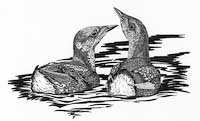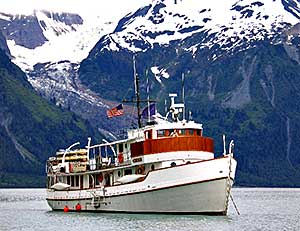 WILD OCEAN MISTS: WILD OCEAN MISTS:
A NATURALIST’S
VOYAGE TO
GLACIER BAY NATIONAL
PARK
AND LITUYA BAY
May 10-21, 2009
10 nights/10 days aboard M/V Sea Wolf
Dr. Al Werner, Audrey Benedict, Kimber
Owen, and the M/V Sea Wolf Crew
Imagine Glacier Bay as John Muir saw it in 1899,
as a member of the legendary Harriman Expedition—
without the cruise ships, the guidebooks,
and interpretive signs that define the modern visitor’s
experience. Aboard the
 M/V Sea Wolf, a 97-
foot vintage wooden boat, we’ll have the chance
to see this spectacular glacier and fjord landscape
in much the same way that Harriman’s scientists
did. Glacial geologist Al Werner, like his historic
counterpart on the Harriman Expedition, explorerscientist
Grove Karl Gilbert, will help us trace the
evidence of climatic change left behind by the
advance and retreat of these immense glaciers—
the stories behind the scenery both dramatic
and compelling. Unlike the big cruise ships,
M/V Sea Wolf is trim enough to explore the narrowest
of fjords and shallow coastal waters. She
carries twelve passengers and a crew of five—the
perfect size for a voyage such as ours. Best of all,
Sea Wolf carries a full complement of sea kayaks
and a motorized inflatable to enable exploration
both far and wide. For those who take paddle in
hand, the use of sea kayaks allows a more intimate,
seal’s eye view of the tidewater glaciers,
inlets, islets, and estuary streams that make this
coastal wilderness one of North America’s richest
and most biologically diverse areas.
M/V Sea Wolf, a 97-
foot vintage wooden boat, we’ll have the chance
to see this spectacular glacier and fjord landscape
in much the same way that Harriman’s scientists
did. Glacial geologist Al Werner, like his historic
counterpart on the Harriman Expedition, explorerscientist
Grove Karl Gilbert, will help us trace the
evidence of climatic change left behind by the
advance and retreat of these immense glaciers—
the stories behind the scenery both dramatic
and compelling. Unlike the big cruise ships,
M/V Sea Wolf is trim enough to explore the narrowest
of fjords and shallow coastal waters. She
carries twelve passengers and a crew of five—the
perfect size for a voyage such as ours. Best of all,
Sea Wolf carries a full complement of sea kayaks
and a motorized inflatable to enable exploration
both far and wide. For those who take paddle in
hand, the use of sea kayaks allows a more intimate,
seal’s eye view of the tidewater glaciers,
inlets, islets, and estuary streams that make this
coastal wilderness one of North America’s richest
and most biologically diverse areas.
May is a magical time to be in Glacier Bay
National Park because we have it largely to ourselves—
just the bears, the first returning humpback
whales, and the thousands of migrating
shore and seabirds bound for Arctic nesting sites.
Both Glacier Bay and Lituya are major stops on
the Pacific Flyway. Against a backdrop of some of
the most magnificent mountains on earth, rivers
of glacial ice tumble into the sea and aquamarinecolored
icebergs drift by on the tides. Responding
to the boom and crash of ice at the glacier front,
kittiwakes and Arctic terns swirl over the churning,
welling waters in search of food. Western
sandpipers and other shorebirds skitter along the
shorelines, poking their bills into the food-rich
mud and gravels of the intertidal zone. Sea ducks
and enormous rafts of harlequin ducks forage in
the quiet bays before making the final push to
their nesting areas. Grizzlies and black bears, recently
emerged from their hibernation dens, can
be seen bending down the branches of black cottonwoods
to feed on the sweetly-resinous leaf
buds, grazing on swards of lush sedges, and
scraping succulent barnacles and mussels from
rocks along the water’s edge. For wildlife, this is
indeed a time of plenty.
Along the wild, storm-battered coastline of the
Gulf of Alaska, just south of the Tlingit village of
Yakutat, a whale-shaped fjord—Lituya Bay—lies
at the foot of the spectacular Fairweather Range.
Nowhere else in the world do mountains tower so
far above the sea. The only access to this legendary
wilderness arm of Glacier Bay National Park
is by small boat or seaplane—well beyond the
capabilities of most Park visitors. Lituya Bay is
situated at the confluence of three glaciers—the
Lituya, the Cascade, and the North Crillon—and
centered along a T-shaped epicenter of intense
geologic activity known as the Fairweather Fault.
Since 1899, nine earthquakes have rumbled across
the region, toppling mountains and flaying this
ice-carved land to its bedrock roots. In 1958, a
magnitude 8.3 earthquake centered on Cross
Sound, located forty-five miles to the southeast,
set the fjord into earth-wrenching motion. The
collapse of an entire mountainside near the head
of Lituya Bay triggered a 1,740-foot tsunami-like
wave. The wave completely decapitated the snout
of Lituya Glacier, scoured all the trees from the
walls of the fjord, and destroyed three fishing
boats anchored in the bay. The swirling maelstrom
took a tremendous toll on the bay’s wildlife—seabirds,
fish, marine animals, whales, bears, and
wolves. For humans, the quake was no less devastating.
Today, despite its violent history, Lituya
Bay offers some of the most spectacular wilderness
to be found anywhere. Join us for this very
special voyage of discovery!
Price: $4,850 (includes a $500 deposit)
Group Size: 12
Trip Rating: 2-3
Price Includes: 10 nights/10 days aboard
M/V Sea Wolf,
comfortable cabins with private
facilities, all meals and beverages, one group dinner
in Juneau, the services of a five-person crew
and three naturalist leaders, a copy of The Nature
of Southeast Alaska, one nights’ lodging in Juneau
(May 20), roundtrip/scenic charter float-plane
flight (includes a 1 hr. 45 min. scenic tour) from
Juneau to Gustavus and back, all boat/hotel transfers,
full sea kayak outfitting and instruction, and
gratuities to the Sea Wolf crew.
Does not include roundtrip airfare or other transportation to Juneau
from your point of departure.
More information? Visit Sea Wolf Adventures at seawolfadventures.com for pictures
of the M/V Sea Wolf, the boat’s layout,
amenities, and crew biographies. For the
adventure-bound, mobility-challenged traveler,
the M/V Sea Wolf has
been retrofitted for
wheel chair accessibility
and provides a lift
between decks and full
sea kayak support. |
